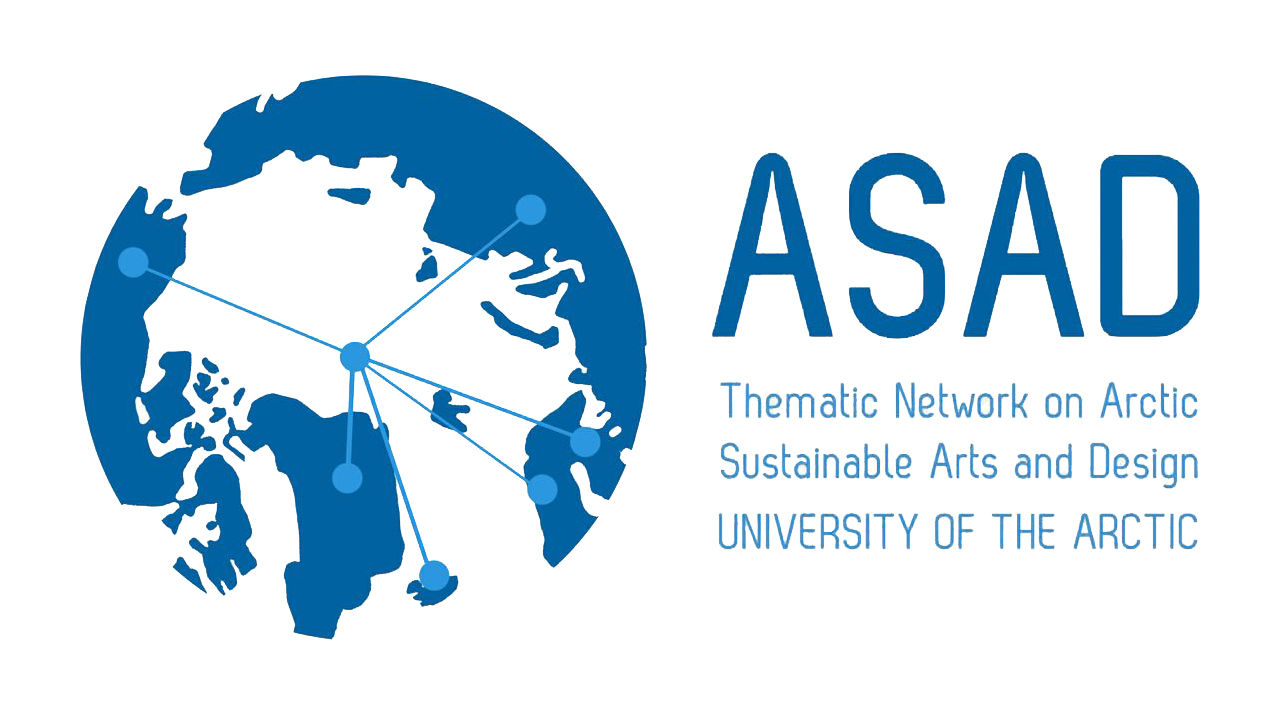ARCTIC SUSTAINABLE ARTS AND DESIGN
The Arctic Sustainable Arts And Design Network Is A Thematic Network Of The University Of The Arctic
The North contains a vast set of knowledge and skills, built over generations by indigenous peoples and other northerners and manifested in the region’s modern institutions of knowledge held by communities – for the future of the arts, design and visual culture in the Circumpolar North!
The Arctic Sustainable Arts and Design (ASAD) is a Thematic Network that aims to identify and share contemporary and innovative practices in teaching, learning, research and knowledge exchange in the fields of arts, design and visual culture education. Members of the network include art and design institutions and art education universities across the circumpolar area. The network provides opportunities to combine traditional knowledge with contemporary academic knowledge cultures in northern academic institutions.
What is ASAD?
The North possesses a vast set of knowledge and skills, built over generations by indigenous peoples and other northerners and manifested in the region’s modern institutions of knowledge held by communities – for the future of the arts, design and visual culture in the Circumpolar North!
Arctic Sustainable Arts and Design (ASAD) is a Thematic Network that aims to identify and share contemporary and innovative practices in teaching, learning, research and knowledge exchange in the fields of arts, design and visual culture education. The network consists of art and design art education universities in the circumpolar area. Combining traditional knowledge with modern academic knowledge cultures at northern academic institutions represents an opportunity unique to the Arctic.
Although many of the goals and activities within the network are shared by all of the members, there are also differences in the societal contexts of art and design. For instance actors, organizations, forums, as well as sources for funding are often different between art and design. Art and visual culture takes place for example in art museums, galleries, art institutions, schools and cultural events by artists, curators and audiences, whereas design is often connected with industrial organizations or societal planning activities. Thus the network includes two Special Interest Groups (SIG): Arctic Arts and Visual Culture Education (AAVCE) and Arctic Sustainable Design (Design).
The University of the Arctic (UArctic) is an international cooperative network behind the ASAD network. UArctic is also based in the circumpolar region. The overall and shared goal with the University of the Arctic is to create a strong, sustainable circumpolar region by empowering indigenous peoples and other northerners through education, mobility and shared knowledge. Key elements of the vision of UArctic include strengthening the voice of the Arctic in the world as well as the world’s understanding of the Arctic. The peoples of the North have the right to choose a path to their own future. Respect, knowledge, and building northern competence can ensure northerners have a strong say and receive fair benefits from the export value of northern resources.
Network Leader
Professor Timo Jokela
timo.jokela[at]ulapland.fi
Arctic Arts and Visual Culture Education
UNESCO goals for the development of Arts Education contain a comprehensive plan of action for all arts education stakeholders. Among the resolutions the following two points are pertinent to the SIG: AAVCE holds particular interest towards recognizing and developing cultural well-being dimensions of arts education. The SIG will also support and enhance the role of arts education in the promotion of social responsibility, social cohesion, cultural diversity and intercultural dialogue. In pursuit of these, AAVCE brings together experts from across the Arctic to review and critically analyse practice through arts-based research methods.
- SIG objectives / Arctic Arts and Visual Culture Education
- Implement the relevant parts of the UNESCO goals for Arts Education in the Arctic area
- Identify and develop the rich cross section of contemporary art and traditional visual cultures of the arctic region
- Foster community-based art and visual culture education
- Use arts and visual culture for empowerment of the inhabitants in the Arctic area inspired by the arctic nature, culture and environment
- Increase the profile and sharing of traditional and new arts and visual culture education practices across the Arctic area.
Arctic Sustainable Design
As the Arctic region is a very unique context as a natural, political, cultural and historical environment, it poses particular challenges from the perspective of design. The particular features related with sustainable design in the Arctic context are still vastly under explored. As such, these issues present a promising connecting theme for interdisciplinary discussion and also a potential platform for integrating multidisciplinary research in the development of the sustainable material objects, facilities and environments in the Arctic. A prominent feature in the discussion is the interest towards the meanings given by the users of the designed products, services and environments, but other perspectives are also welcomed. The SIG may approach the issue of Arctic Sustainable Design from i.e. aesthetic, semiotic, functional, technical, legal, economic, sociological, educational, environmental, cultural or historical perspectives, but the viewpoints are not limited to these.
SIG objectives / Arctic Sustainable Design
- Promote the idea of sustainable design in the planning of products, services and environments in the Arctic region
- Foster interdisciplinary and international collaboration in the context of sustainable design research and education in the Arctic region
- Aims to improve the opportunities for the northern residents to be involved in designing in the Arctic
- Strengthens the visibility of the Arctic region and communities within the design field
- Advances integration of interdisciplinary research and user experience in design practice in the Arctic
- As the SIG Design is interested in the perspective of the northern residents particularly as users and creators of designed products, services and environments it also addresses issues that are related with indigenous peoples. The indigenous peoples’ traditional ways of life that become visible in their often handcrafted products may be an interest particularly in the context of jewellery, clothing and craft design.
